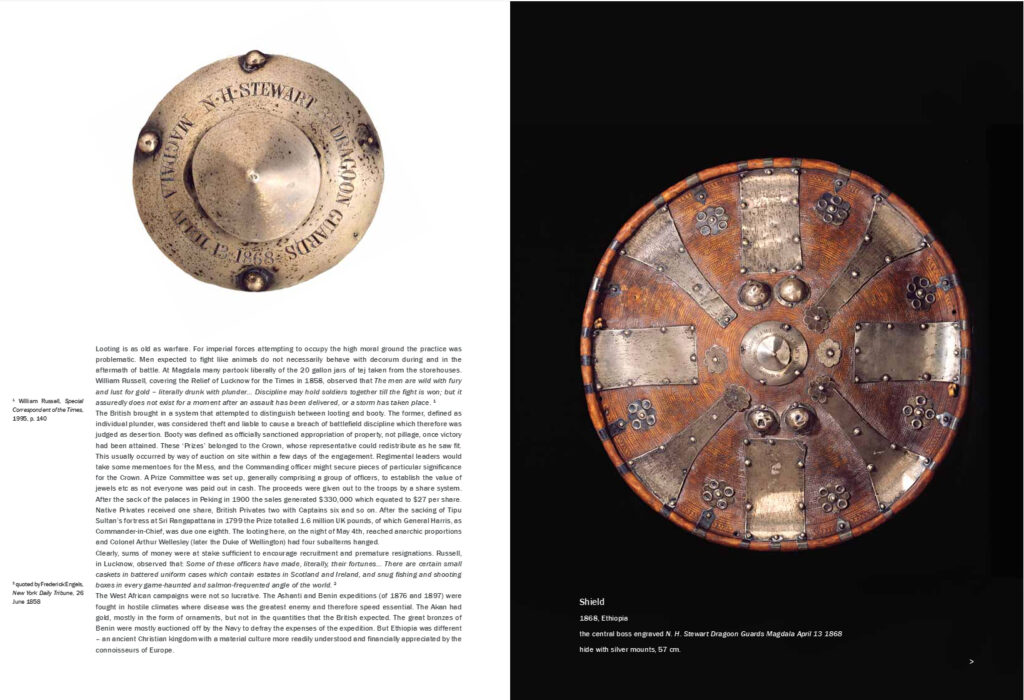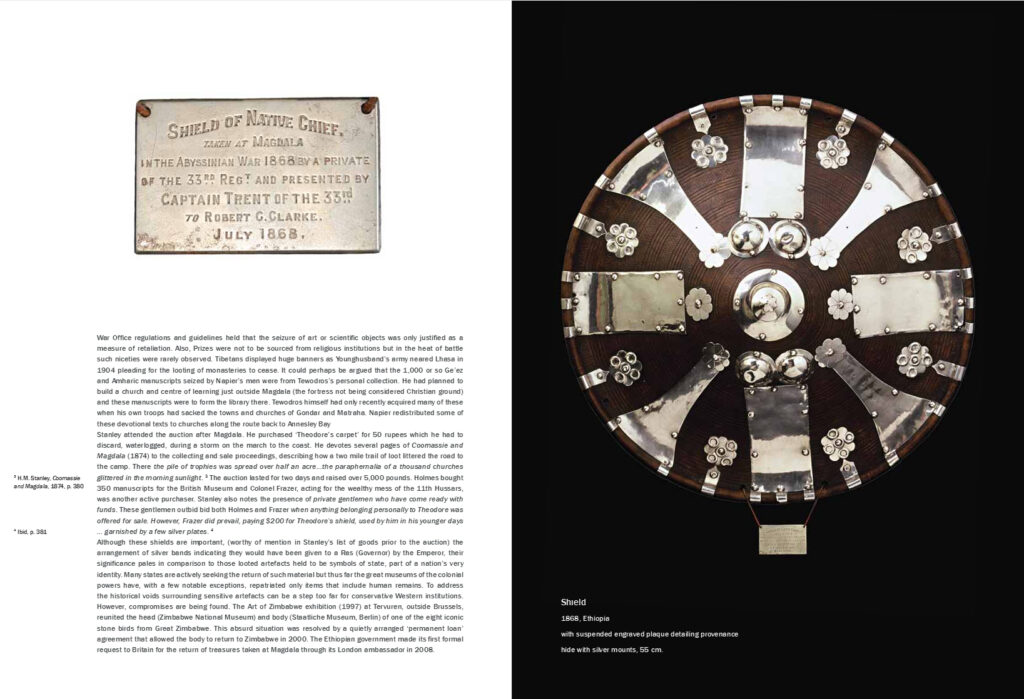What: A processional cross showing scenes from the martyrdom of St George, given by Secretary of State for India, Sir Stafford Henry Northcote
Where: The British Museum, Great Russell St, Bloomsbury, London WC1B 3DG
The catalogue entry reads:
“Processional cross cast in bronze in four parts; hollow shaft, two lower arms and cross engraved and gilded. The tapered shaft has two bands of moulding and a long vertical slot at the top into which the body of the cross sits, held in place with one nail, another is missing. Two square plates extend out from the shaft onto which the lower arms are slotted and secured with two nails. The surface is gilded and the join is very smooth. The lower arms curve upwards and are engraved both front and back with angels, holy images and Ge’ez inscriptions and have three finial crosses. Each arm ends with a circle which encloses a cruciform motif and a slotted lozenge shaped extension which supports the body of the cross.
The cross is formed by a patée cross with arms which flare extensively and join, creating ovoid cut outs known as dove’s eyes. The arms are further embellished to resemble fleur-de-lys in shape. At each axis is a semicircular cut out with finial cross and four finial crosses at the points where the arms join. The surface of the cross is engraved with holy images and Ge’ez inscriptions and in some areas a punched design has been used as a background to contrast with the gilded imagery.
Front, clockwise from top; Saint George is depicted mounted on a finely caparisoned horse decorated with birds, stars, flowers and moons. He carries a long spear with a cross finial, wears an elaborate crown with crosses and a cape decorated with stars, flowers and a large clasp. To his left are a band of warriors on horseback carrying spears and to his right are his three retainers, Saqrates, Lolis and Herpas, carrying swords and guns. The three men wear skin capes, lemd and follow an angel in a cloud representing the protection of the Holy Spirit.
In the centre of the cross Saint George is shown seated with his hand raised in a gesture of blessing while to his right a retainer lifts the lid of a treasure box to represent how the saint gave away his wealth to the poor. Below, a crowd of people look up towards the saint. To the left Saint Gabriel is depicted carrying a flower in a pose reminiscent of paintings of the annunciation. He points towards Mary who is seated with the infant Christ on her lap. Both figures are surrounded by stars. To the right is an angel with a drawn sword (Saint Michael). Above are two saints, one with wings and below is a figure in Ethiopian dress with arms folded across the chest in supplication.
To the right of the shaft of the cross is a figure in a loin cloth with arms raised in prayer with an angel and floral motif. The top of the shaft is engraved with the seventy kings being burnt with fire. Below Saint George is shown converting Queen Alexandria, wife of King Dudyanos. The queen is shown in profile and both she and Saint George drink from glass berelle. King Dudyanos is shown sleeping and in profile.
To the left of the shaft is a haloed figure in a loin cloth surrounded with floral motifs and an angel. Wallata Giorgis, Empress Mentuab is shown prostrate and standing beside her is her son Emperor Iyasu II. Above, is Saint George his face and hands deeply engraved shown on horseback spearing a dragon. Behind him are a band of warriors wearing lemd, carrying swords and in front is the maiden Birutawit with her arms folded in front of her.Back, clockwise from top; Mary is depicted with her hands raised to her face in grief to the right of the Crucifixion and Saint John is to the left. Christ has an elaborate halo and patterned loincloth. Two angels collect his blood in small chalices. The cross is surmounted by a smaller cross and is surrounded by falling stars, the sun and the moon. The skull of Adam can be seen upside down at the base. To the left are scenes from the martyrdom of Saint George and his tormentors are all shown in profile.
The first figure is shown scattering the remains of Saint George’s body, two men force Saint George into an ox with a fire underneath, the saint is tied to a stake and beaten, he is put into a brass pot and put on a fire and he is forced to walk on all fours in spiked shoes. Below is the image of a supplicant in Ethiopian dress. To the right of the shaft of the cross two men press a spike through the body of the saint. Below is a supplicant, Yordanos.
The shaft of the cross is engraved with the image of Christ holding Saint George, an angel with a large stone and a pendant with sun and stars.
To the left of the shaft Saint George is shown tied to a stake while a man puts a saw to his body. To the left is the supplicant Walda Yohannis shown in prayer. Above, Saint George is depicted tied to the beam of a round house belonging to an old woman who is shown to the left and to the right of the house is her son. The leaves sprouting from the top of the roof refer to the miracle of the beam which grew as a tree. To the left is an angel with a chalice and lidded pot. The next scene shows Saint George’s head being cut off with a sword. Above, is King Dudyanos seated on a throne ordering the death of Saint George. Above his crown is a small horned creature.”
Inscription Translations
How saint George was crowned, Saint George, Saint George, How he scattered his wealth to the poor, Saint Gabriel, With her beloved son, […] , […], How the nation pleads (for intercession) to Saint George, Angel, Wallata Giorgis, Emperor Iyasu, How Saint George killed the dragon, Birutawit.
How saint George is recieved by the Holy Spirit.
This cross was made on account of the ordination of Walda Yohannis [son of priest Tasafa Giorgis priest […] heaven ](?).
Our Lady, John, Image of the Crucifixion, How they sifted him, Image of brass (pot), [unknown], How they put him in the brass pot, […], […], This cross of Saint George […], How he endured the stake, Yordanos, […], […], How Walda Yohannis prayed, Son of old woman, Saint George, Old woman, How the angel, How he was tied to the […] of the old woman, How Saint George was cut with a sword, Dudyanos how he ordered the head of Saint George to be cut with a sword.
This cross is for Saint George and for High Priest Walda Yohannis
Just as fire consumed the seventy kings
Just as our Lord saves
Curator’s comments: Processional crosses in Ethiopia are considered sacred and long wooden staffs are usually inserted into the hollow shaft to enable the cross to be carried aloft and to prevent the body of the cross from being touched. Often a cloth is placed through the lower arms, reminiscent of Christ’s loin cloth worn at the Crucifixion. The cross is processed during the church liturgy and at religious festivals and is used to bless the faithful. This particular cross is engraved with graphic depictions of the Martyrdom of Saint George who is the Patron saint of Ethiopia and closely associated with the Ethiopian Imperial family. The depictions closely follow the description of the Saint’s Martyrdom written in a manuscript which was commissioned by Wallata Giorgis, Empress Mentawab and her son, Iyasu II which is now in the collections of The British Library (MS Orient 686). The richness and detail of the engraving on the cross is very typical of crosses made at Gondar during the mid 18th century. The distinctive depiction of Saint Gabriel in flowing robes, holding a flower is similar to an image of the Saint in a painting commissioned by Iyasu II. The key figures of Saint George, Mary and Christ all have deeply engraved faces and hands which give them a three dimensional quality. The construction of the cross shows considerable skill and the points where the lower arms join the staff have been carefully smoothed and concealed with gilding.”
Exhibition history Exhibited:
1978, London, British Museum, Christian Orient “Introduction to the collections”, Museum of Mankind, 1987 2012-2013 Nov- March, Bonn, KAH, Treasures of the World’s Cultures
2015-2016 4 Dec- 03 Jul, Singapore, National Museum, Treasures of the World’s Cultures
Detail
Museum number: Af1868,1230.7
Date: 1730-1755
Acquisition name: Sir Stafford Henry Northcote, 1st Earl of Iddesleigh
Acquisition date: 1868



